This article introduces the paper "Advances in Technology of Soluble Cores for Die Castings".
Title: Advances in Technology of Soluble Cores for Die Castings
- Core Research Objective: To develop and analyze new soluble core technologies, particularly salt cores, as a replacement for conventional metal cores in high-pressure die casting. The research aims to determine the factors affecting the properties (strength, porosity, solubility) of salt cores—including the type of salt, binder usage, and compression/injection methods—and establish optimal manufacturing processes. Furthermore, the study investigates methods for managing the salinity of circulating water to create an efficient cleaning system.
- Main Methodology: Salt cores were manufactured using high-pressure compression and injection methods, employing alkali silicate binders to enhance core strength. Experiments compared core properties using various types of cooking salts. Core strength, porosity, and solubility were measured. Circulating cleaning water salinity was monitored using electrical conductivity measurements. Experiments also focused on developing salt core bonding techniques.
- Key Findings: KCl cores exhibited higher high-temperature strength than NaCl cores. The addition of alumina (Al₂O₃) and other additives significantly improved core strength. Injection-molded cores showed higher porosity than compressed cores but achieved comparable strength with alkali silicate binders. Circulating water salinity could be effectively managed by monitoring electrical conductivity; higher salinity reduced core dissolution rate. Experiments demonstrated the feasibility of bonding salt cores using various adhesives.
Research Team Information
- Affiliation: VŠB – Technical University of Ostrava, Department of Metallurgy and Foundry
- Authors: P. Jelínek, E. Adámková, F. Mikšovský, J. Beňo
- Research Areas: Metallurgy and Foundry Engineering, Soluble Core Technology
Research Background and Objectives
- Industrial Background: Conventional metal cores limit the complexity of castings achievable in die casting. Soluble cores offer the potential for producing intricate parts and simplifying post-processing, thus increasing productivity.
- Specific Technical Challenges: Existing soluble cores lacked sufficient strength, durability, and precision for high-pressure die casting applications. Improving process efficiency and addressing wastewater treatment issues were crucial.
- Research Goals: Develop high-strength, high-precision soluble salt cores suitable for high-pressure die casting, and establish an efficient cleaning system for managing wastewater salinity.
Main Objectives and Research Content
- Main Objectives and Research Content: Manufacturing and characterizing soluble salt cores for high-pressure die casting. The research included core manufacturing methods (high-pressure compression, injection), the use of binders, and management of circulating wash water.
- Problems: Limitations of conventional metal cores, low strength and precision of existing soluble cores, inefficient cleaning processes.
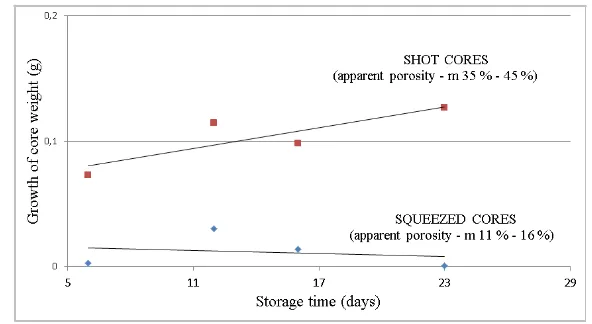 Fig. 1. Comparison of hygroscopicity of squeezed and shot cores of the same composition (conditions RH 35 – 58 %, T = 20.7 – 24.9 °C)
Fig. 1. Comparison of hygroscopicity of squeezed and shot cores of the same composition (conditions RH 35 – 58 %, T = 20.7 – 24.9 °C)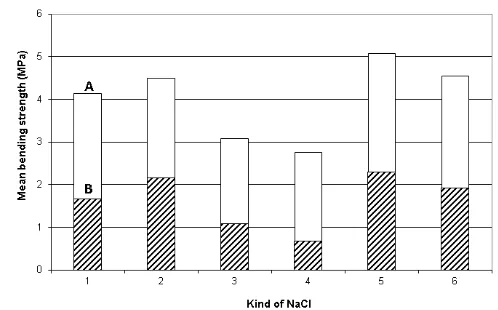 Fig. 2. Comparison of strengths of salt cores squeezed and shot from different kinds of cooking salts (mean value from 6 cores; the fraction 0.063 ÷ 1.0 mm; A = SQUEEZED CORES (104 MPa); B = SHOT CORES (the binder Na – SODIUM SILICATE, 7.5-8.0 bar)
Fig. 2. Comparison of strengths of salt cores squeezed and shot from different kinds of cooking salts (mean value from 6 cores; the fraction 0.063 ÷ 1.0 mm; A = SQUEEZED CORES (104 MPa); B = SHOT CORES (the binder Na – SODIUM SILICATE, 7.5-8.0 bar)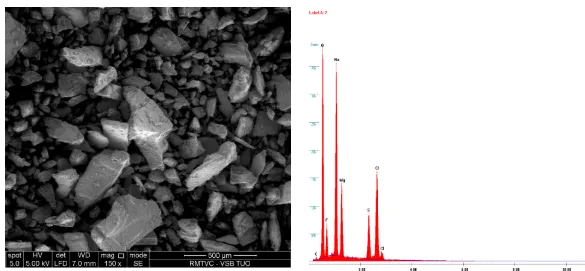
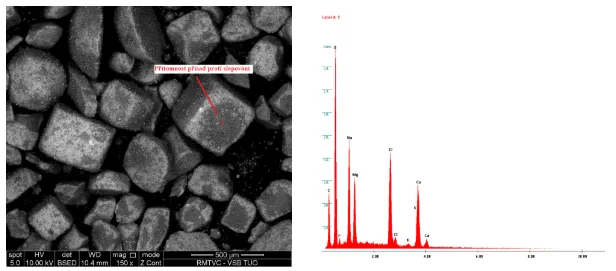 Fig. 4. Regular cubic grains of Alpine salts (samples Nos 3, 4) and EDX analysis confirming the presence of anticaking additives on the salt grain surface (MgCO3, CaCO3)
Fig. 4. Regular cubic grains of Alpine salts (samples Nos 3, 4) and EDX analysis confirming the presence of anticaking additives on the salt grain surface (MgCO3, CaCO3)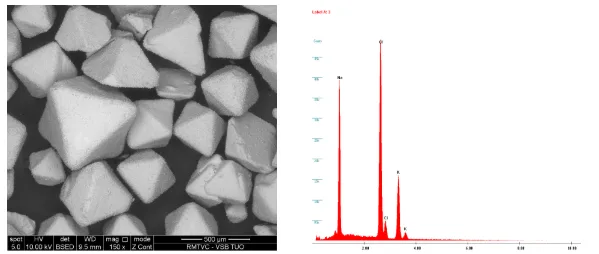 Fig. 5. Dipyramidal regular shape of NaCl, p.a. – standard (sample No 6) and EDX analysis of chemical composition
Fig. 5. Dipyramidal regular shape of NaCl, p.a. – standard (sample No 6) and EDX analysis of chemical composition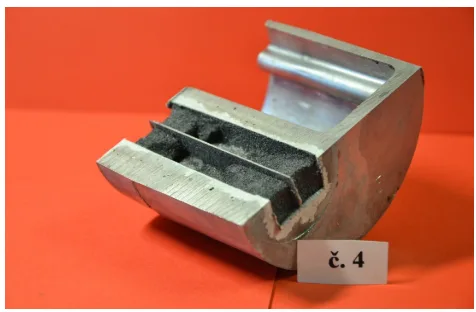 Fig. 6. H 2400 during dissolution of the glued core
Fig. 6. H 2400 during dissolution of the glued core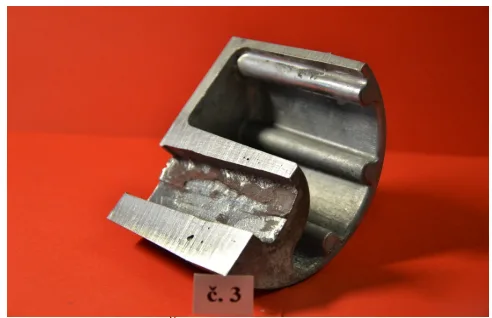 Fig. 7. Test with the VŠB – TUO glue during dissolution of the glued core
Fig. 7. Test with the VŠB – TUO glue during dissolution of the glued core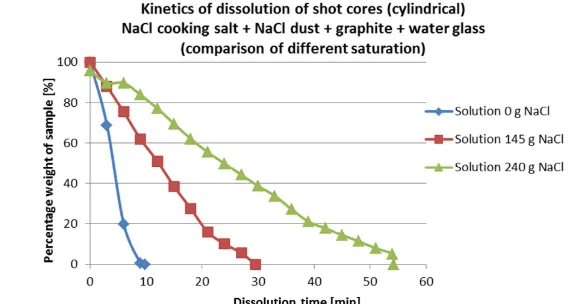 Fig. 8. Comparison of dissolving the salt cores in two types of saturated solutions and in pure water
Fig. 8. Comparison of dissolving the salt cores in two types of saturated solutions and in pure water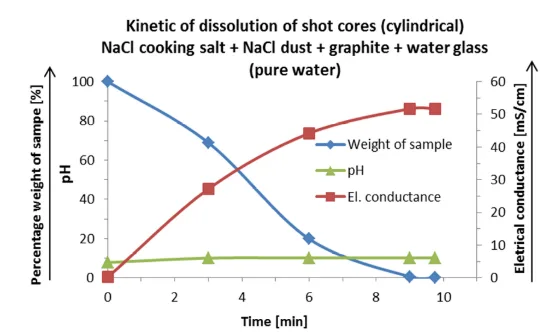 Fig. 9. Kinetics of dissolution of salt cores in dependence on pH and electric conductance
Fig. 9. Kinetics of dissolution of salt cores in dependence on pH and electric conductance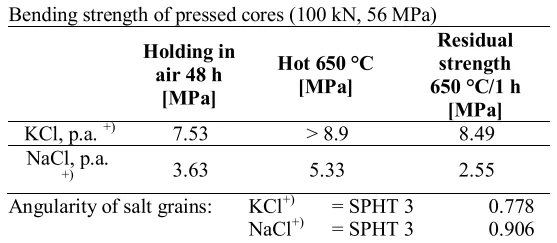 Table 2. Bending strength of pressed cores (100 kN, 56 MPa)
Table 2. Bending strength of pressed cores (100 kN, 56 MPa)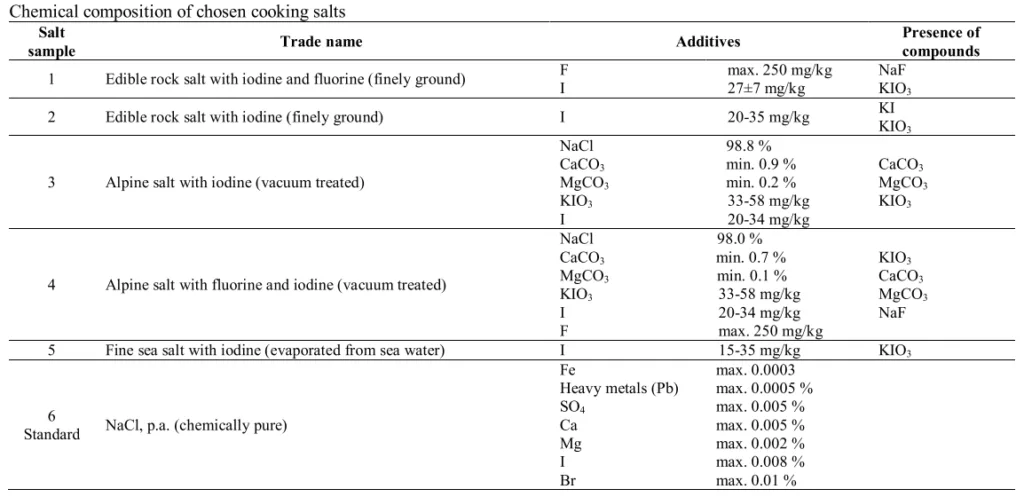 Chemical composition of chosen cooking salts
Chemical composition of chosen cooking salts Strength of core joints (shear strength) salt – salt
Strength of core joints (shear strength) salt – salt Strength of core joints (shear strength) metal – salt
Strength of core joints (shear strength) metal – salt
Results and Achievements
- Quantitative Results: KCl cores showed up to 8.9 MPa flexural strength (at 650°C). Alumina additives tripled core strength. Injection-molded cores had 21.3-23.5% porosity (apparent porosity 35-45%) and 1.5-3.5 MPa flexural strength. Bond strengths were 63-105 N/cm² (salt-salt) and 160-232 N/cm² (salt-metal).
- Qualitative Results: Alkali silicate binders improved core strength and durability. Core strength varied depending on salt crystal morphology. Effective wastewater management was demonstrated via electrical conductivity monitoring. Successful salt core bonding techniques were developed.
- Technical Achievements: Development of a novel soluble salt core manufacturing process for high-pressure die casting. Improvement of core strength and manufacturing efficiency. Development of an efficient wastewater management system.
Copyright and References
This summary is based on the paper "Advances in Technology of Soluble Cores for Die Castings" by P. Jelínek, E. Adámková, F. Mikšovský, and J. Beňo.
Copyright © 2025 CASTMAN. All rights reserved.
This summary is based on the above-mentioned paper and is not permitted for commercial use.